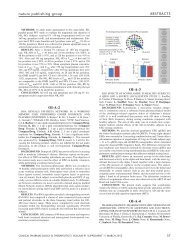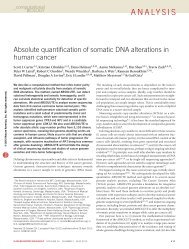open access: Nature Reviews: Key Advances in Medicine
open access: Nature Reviews: Key Advances in Medicine
open access: Nature Reviews: Key Advances in Medicine
You also want an ePaper? Increase the reach of your titles
YUMPU automatically turns print PDFs into web optimized ePapers that Google loves.
NEUROLOGY<br />
levels of auto antibodies aga<strong>in</strong>st α-synucle<strong>in</strong>,<br />
the ma<strong>in</strong> component of Lewy bodies, <strong>in</strong> the<br />
serum of patients with PD <strong>in</strong> early and late<br />
stages of the disease. Significantly higher<br />
auto antibody levels were found <strong>in</strong> patients<br />
than <strong>in</strong> controls, but the antibody response<br />
decreased as the condition became more<br />
advanced. The authors <strong>in</strong>terpreted this<br />
f<strong>in</strong>d <strong>in</strong>g <strong>in</strong> the context of a protective role for<br />
auto immunity <strong>in</strong> PD that seems to be stronger<br />
<strong>in</strong> the early phases of the disease, and<br />
may be of value as a biomarker, especially at<br />
this crucial stage of PD pathogenesis.<br />
‘‘ …the treatment of PD has<br />
been limited to symptomatic<br />
drug therapy and deep bra<strong>in</strong><br />
stimulation<br />
In the absence of neuroprotective therapies,<br />
the treatment of PD has been limited<br />
to symptomatic drug therapy and deep<br />
bra<strong>in</strong> stimulation. To explore the potential<br />
of gene therapy, LeWitt and colleagues<br />
performed the first double-bl<strong>in</strong>d, shamsurgery-<br />
controlled, randomized trial of<br />
<strong>in</strong> vivo gene transfer <strong>in</strong> patients with PD. 9<br />
The <strong>in</strong>vestigators used adeno-associated<br />
viral vector (AAV2) for transduction of<br />
the gene encod<strong>in</strong>g glutamic acid decarboxylase<br />
(GAD), an enzyme that catalyzes<br />
the decarb oxylation of glutamate to<br />
γ-am<strong>in</strong>obutyric acid and is expected to<br />
<strong>in</strong>crease the <strong>in</strong>hibitory tone <strong>in</strong> the basal<br />
ganglia. The trial <strong>in</strong>volved 55 patients aged<br />
30–75 years with levodopa-responsive<br />
PD, who were randomly assigned to sham<br />
surgery (n = 23) or AAV2–GAD <strong>in</strong>fusions<br />
(n = 22) at basel<strong>in</strong>e.<br />
At the 6-month study end po<strong>in</strong>t, 21 and<br />
16 patients were assessed <strong>in</strong> the shamtreated<br />
and gene-therapy groups, respectively.<br />
The mean Unified Park<strong>in</strong>son’s<br />
Disease Rat <strong>in</strong>g Scale (UPDRS) motor score<br />
was found to have decreased by 8.1 po<strong>in</strong>ts<br />
(23.1%) <strong>in</strong> the AAV2–GAD group and<br />
by 4.7 po<strong>in</strong>ts (7.0%) <strong>in</strong> the sham group. 9<br />
’’<br />
Over all, the study is encourag<strong>in</strong>g, s<strong>in</strong>ce the<br />
group dif ference was highly significant and<br />
no serious adverse events were observed <strong>in</strong><br />
either group. Caveats of this study <strong>in</strong>clude<br />
rela tively small group sizes, a heterogeneous<br />
patient population <strong>in</strong> terms of age of onset,<br />
more-severe dis ease <strong>in</strong> the sham group,<br />
limited dis crim<strong>in</strong>atory power of the UPDRS<br />
(maximum 108 po<strong>in</strong>ts) <strong>in</strong> the lower range,<br />
and the relatively short follow-up period.<br />
In conclusion, these studies highlight the<br />
importance of identify<strong>in</strong>g the molecular<br />
underp<strong>in</strong>n<strong>in</strong>gs of disease pathways to<br />
uncover therapeutic targets. The discovery<br />
of genetic mutations <strong>in</strong> these pathways has<br />
sug gested converg<strong>in</strong>g mechanisms <strong>in</strong> the<br />
patho genesis of movement disorders. In<br />
order to rapidly translate research advances<br />
<strong>in</strong>to the cl<strong>in</strong>ic, it is critically important to<br />
iden tify markers of disease progression,<br />
especially <strong>in</strong> <strong>in</strong>dividuals who are at risk of<br />
develop<strong>in</strong>g a neurodegenerative disease.<br />
Department of Neurology, University of Lübeck,<br />
Ratzeburger Allee 160, 23538 Lübeck,<br />
Germany (C. Kle<strong>in</strong>). Department of Neurology,<br />
Massachusetts General Hospital, Harvard<br />
Medical School, 114 16 th Street, Room 2007,<br />
Charlestown, MA 02129, USA (D. Kra<strong>in</strong>c).<br />
Correspondence to: C. Kle<strong>in</strong><br />
christ<strong>in</strong>e.kle<strong>in</strong>@neuro.uni-luebeck.de<br />
Acknowledgments<br />
C. Kle<strong>in</strong> is funded by a career development award<br />
from the Hermann and Lilly Schill<strong>in</strong>g Foundation.<br />
D. Kra<strong>in</strong>c is supported by the National Institute of<br />
Neurological Disorders and Stroke and the<br />
CHDI Foundation.<br />
Compet<strong>in</strong>g <strong>in</strong>terests<br />
The authors declare no compet<strong>in</strong>g <strong>in</strong>terests.<br />
1. Dorsey, E. R. et al. Projected number of people<br />
with Park<strong>in</strong>son disease <strong>in</strong> the most populous<br />
nations, 2005 through 2030. Neurology 68,<br />
384–386 (2007).<br />
2. Mazzulli, J. R. et al. Gaucher disease<br />
glucocerebrosidase and α‑synucle<strong>in</strong> form a<br />
bidirectional pathogenic loop <strong>in</strong><br />
synucle<strong>in</strong>opathies. Cell 146, 37–52 (2011).<br />
3. Kisk<strong>in</strong>is, E. & Eggan, K. Progress toward the<br />
cl<strong>in</strong>ical application of patient‑specific<br />
pluripotent stem cells. J. Cl<strong>in</strong>. Invest. 120,<br />
51–59 (2011).<br />
4. Vilar<strong>in</strong>o‑Guell, C. et al. VPS35 mutations <strong>in</strong><br />
Park<strong>in</strong>son disease. Am. J. Hum. Genet. 89,<br />
162–167 (2011).<br />
5. Zimprich, A. et al. A mutation <strong>in</strong> VPS35,<br />
encod<strong>in</strong>g a subunit of the retromer complex,<br />
causes late‑onset Park<strong>in</strong>son disease. Am.<br />
J. Hum. Genet. 89, 168–175 (2011).<br />
6. Kumar, K. W. et al. Frequency of the D620N<br />
mutation <strong>in</strong> VPS35 <strong>in</strong> Park<strong>in</strong>son disease. Arch.<br />
Neurol. (<strong>in</strong> press).<br />
7. Lill, C. M. & Bertram, L. Complex genetics of<br />
neurodegenerative diseases. Sem<strong>in</strong>. Neurol.<br />
(<strong>in</strong> press).<br />
8. Yanamandra, K. et al. α‑Synucle<strong>in</strong> reactive<br />
antibodies as diagnostic biomarkers <strong>in</strong> blood<br />
sera of Park<strong>in</strong>son’s disease patients. PLoS ONE<br />
6, e18513 (2011).<br />
9. LeWitt, P. A. et al. AAV2–GAD gene therapy for<br />
advanced Park<strong>in</strong>son’s disease: a double‑bl<strong>in</strong>d,<br />
sham‑surgery controlled, randomised trial.<br />
Lancet Neurol. 10, 309–319 (2011).<br />
MULTIPLE SCLEROSIS IN 2011<br />
<strong>Advances</strong> <strong>in</strong> therapy, imag<strong>in</strong>g<br />
and risk factors <strong>in</strong> MS<br />
Bianca We<strong>in</strong>stock–Guttman and Murali Ramanathan<br />
Multiple sclerosis research <strong>in</strong> 2011 produced a comb<strong>in</strong>ation of new<br />
therapeutic developments and <strong>in</strong>novative f<strong>in</strong>d<strong>in</strong>gs. Teriflunomide showed<br />
beneficial effects <strong>in</strong> a phase III trial, quantification methods for MRI<br />
lesions that should improve monitor<strong>in</strong>g of disease progression were<br />
devised, and a l<strong>in</strong>k between high cholesterol and low vitam<strong>in</strong> D emerged.<br />
We<strong>in</strong>stock–Guttman, B. & Ramanathan, M. Nat. Rev. Neurol. 8, 66–68 (2012); published onl<strong>in</strong>e 10 January 2012;<br />
doi:10.1038/nrneurol.2011.213<br />
For multiple sclerosis (MS), the research<br />
milestones of 2011 were a comb<strong>in</strong>ation of<br />
new therapeutic developments and <strong>in</strong>novative<br />
f<strong>in</strong>d<strong>in</strong>gs that might help to expla<strong>in</strong> the<br />
heterogeneity <strong>in</strong> both disease progression<br />
and responses to therapy <strong>in</strong> patients with<br />
MS. The new oral therapy teriflunomide<br />
showed beneficial effects <strong>in</strong> a large phase III<br />
cl<strong>in</strong>ical trial, 1 which provides hope for better<br />
and more-convenient control of MS <strong>in</strong> the<br />
future. The identification of new methods<br />
to quantify cortical lesions on MRI will<br />
improve our ability to monitor disease progression,<br />
2 and studies have identified raised<br />
cholesterol and reduced vitam<strong>in</strong> D levels as<br />
detrimental factors <strong>in</strong> patients with MS. 3,4<br />
From a therapeutic standpo<strong>in</strong>t, 2011<br />
will be remembered as a def<strong>in</strong><strong>in</strong>g year<br />
for MS. Follow<strong>in</strong>g a successful cl<strong>in</strong>ical<br />
trial, reported <strong>in</strong> 2010, 5 f<strong>in</strong>golimod—an<br />
oral disease-modify<strong>in</strong>g therapy for MS—<br />
received regulatory approval and became<br />
available to patients <strong>in</strong> over 50 countries<br />
<strong>in</strong>clud<strong>in</strong>g the USA, the European Union<br />
and, most recently, Japan. The results from<br />
a phase III cl<strong>in</strong>ical trial of teriflunomide<br />
(another oral therapy for MS) were published<br />
<strong>in</strong> October 2011 <strong>in</strong> The New England<br />
Journal of Medic<strong>in</strong>e. 1 Teriflunomide is the<br />
active metabolite of leflunomide, which<br />
is already approved for the treatment of<br />
patients with rheumatoid arthritis, and it<br />
S58 | JANUARY 2012 www.nature.com/reviews








